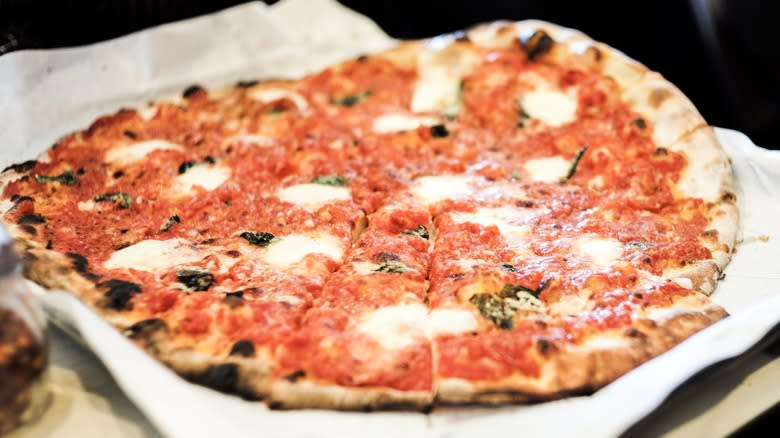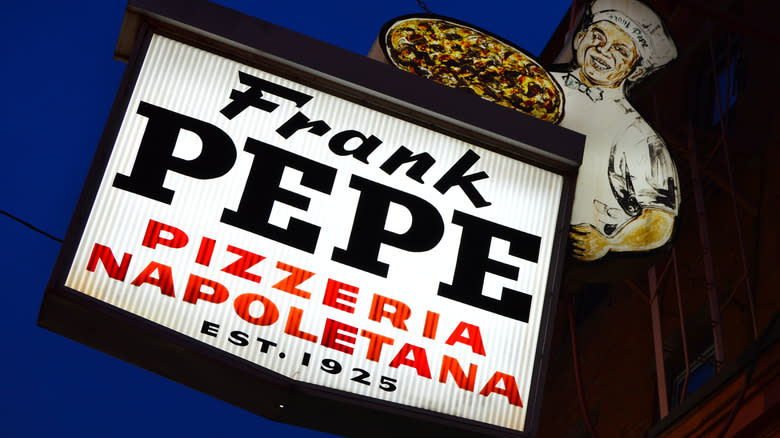What Is Apizza And Is It Really Different From Regular Pizza?

The massive popularity of pizza means you get all sorts of regional varieties of the stuff spread across America (not to mention all the different ways pizza is made around the world). But while you've probably heard of the classic New York pizza, the pepperoni-laden Columbus-style pizza, the thick-crusted rectangular Detroit-style pizza, and the square-cut Chicago thin-crust tavern-style pizza, there's another word you might've seen in the pizza lexicon but could be a bit confused by: apizza.
But is apizza actually different from regular pizza, and where does it come from? The answers are "yes" and "Connecticut." While apizza can be considered a subtype of pizza, it is definitely distinct from the style you might be familiar with from somewhere like Domino's. Its birthplace, meanwhile, is Connecticut, where New Haven-style pizza rules the culinary roost. Anyone who has ever had the pleasure of tasting a true apizza knows the combination of contrasting textures, flavorful crust, salty cheese, unique topping combinations, and just a little bit of char contribute to its signature oomph.
The first thing to know about apizza is you're probably pronouncing it wrong. Though it's written like pizza that hangs out with an extra "a," the actual pronunciation is "ah-BEETZ," a legacy of the Neapolitan pronunciation of the word. Don't call it "a-pizza" in Connecticut, or they'll get very mad at you — and especially don't do so at Frank Pepe's in New Haven, which created apizza in 1925.
Read more: The 101 Best Pizzas In America
The Dough Used For Apizza Is Unusual

The name certainly isn't the only thing that makes apizza stand out, though, as it has a unique cooking process that gives it a texture unlike any pizza you've ever had. Apizza makes use of high-gluten bromated flour, which contains a comparatively massive amount of water, leading to a much wetter dough that's functionally impossible to knead. The benefit of this is that the crust becomes extraordinarily flavorful, but it also means the gluten in apizza is worked primarily from cold fermentation in a fridge overnight. This not only leads to a particularly chewy bite, but also makes the crust visibly bubble in places. On its own, this chewiness might be a problem — but the rest of the apizza cooking process comes to the rescue here, because it lends the crust a signature charred (not burnt!) flavor.
Apizza can only be made very fast at very high temperatures (650 to 725 degrees Fahrenheit) in a coal-fired brick oven — anything else, and it's not apizza. This does cook the pizza fully, but it also cooks the bottom and edges just a bit more than everything else, leading to distinctive char marks and a texture balance between the chewy dough and its crispy crust and underside. That contrast creates a bite unlike any other pizza you've ever had, but the differences don't stop there.
Apizza Is Cooked In A Specific Way

Apizza's cheese and toppings are another way it stands out. Mozzarella is not a universal part of apizza (though it shows up in some applications); instead, it relies on the much saltier and more flavorful pecorino romano. Since apizza generally makes significant use of sauce and the crust is thin, the relative lack of water in Pecorino Romano versus mozzarella helps it keep its structural integrity. The excess water in the crust also means you're limited in how many toppings you can use on an apizza; pile the thing high with ten different ingredients and it'll fall apart.
As a result, apizza generally contains only a few toppings which make up for their lack of diversity with strong individual flavors. The best-known is probably the white clam pie, which makes use of clams, garlic, oregano, olive oil, and mozzarella along with white sauce to create a unique flavor experience. The other classic apizza variety is tomato pie, which goes sauce crazy with just a small amount of cheese.
Really, though, everything about apizza is unique. If you ever get the chance to try some genuine apizza, you won't forget the experience.
Read the original article on The Daily Meal.

 Yahoo Lifestyle
Yahoo Lifestyle 
